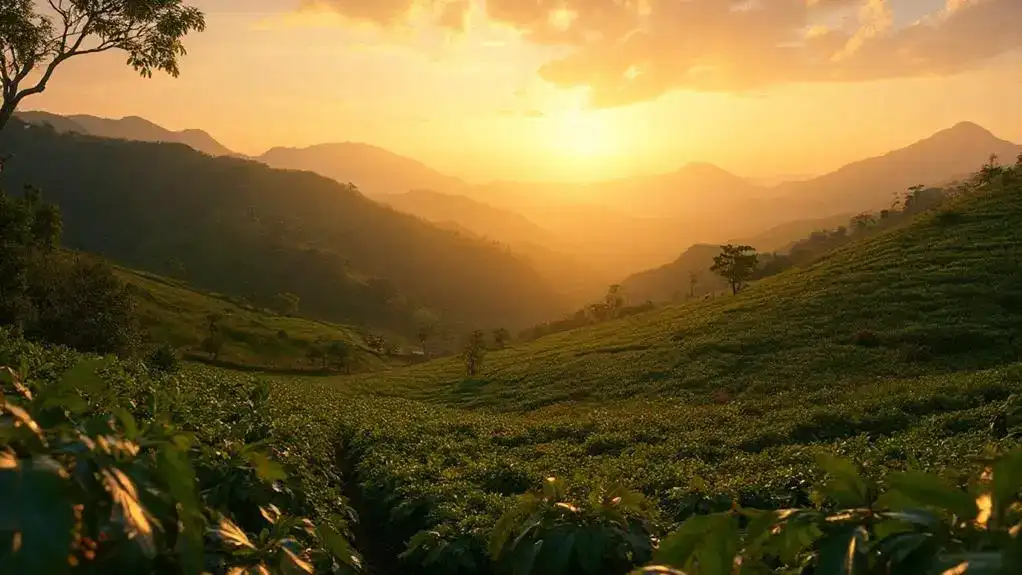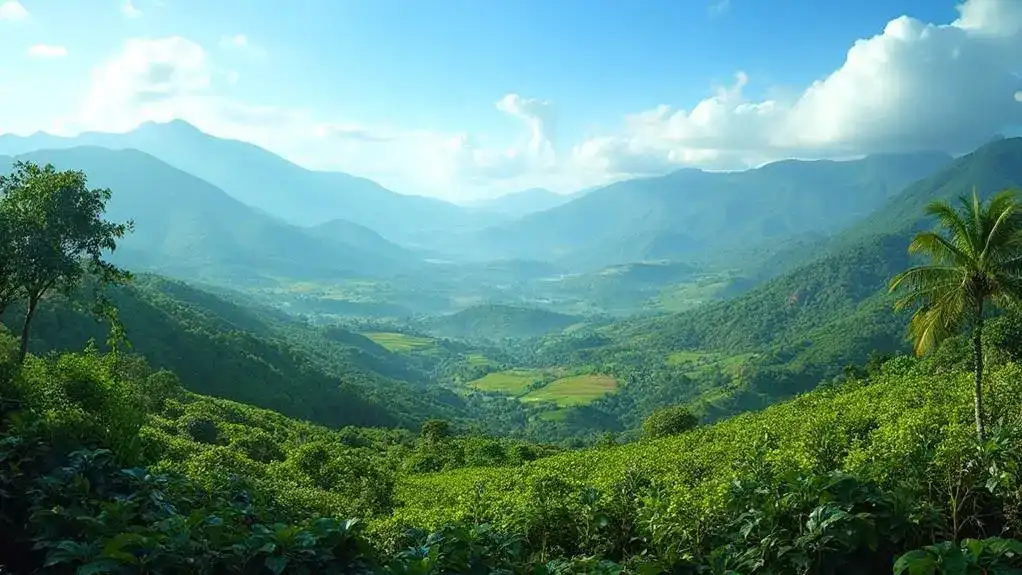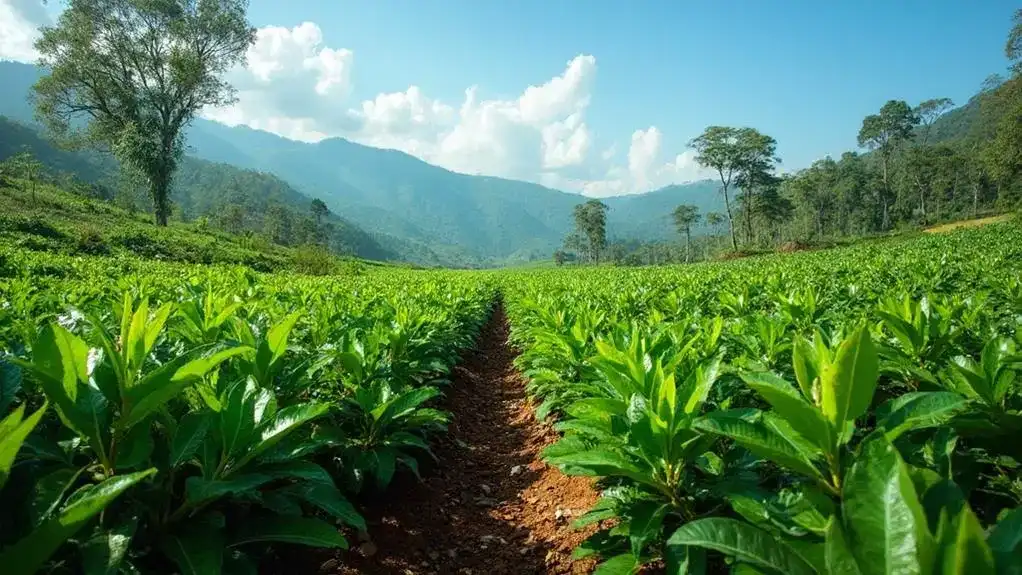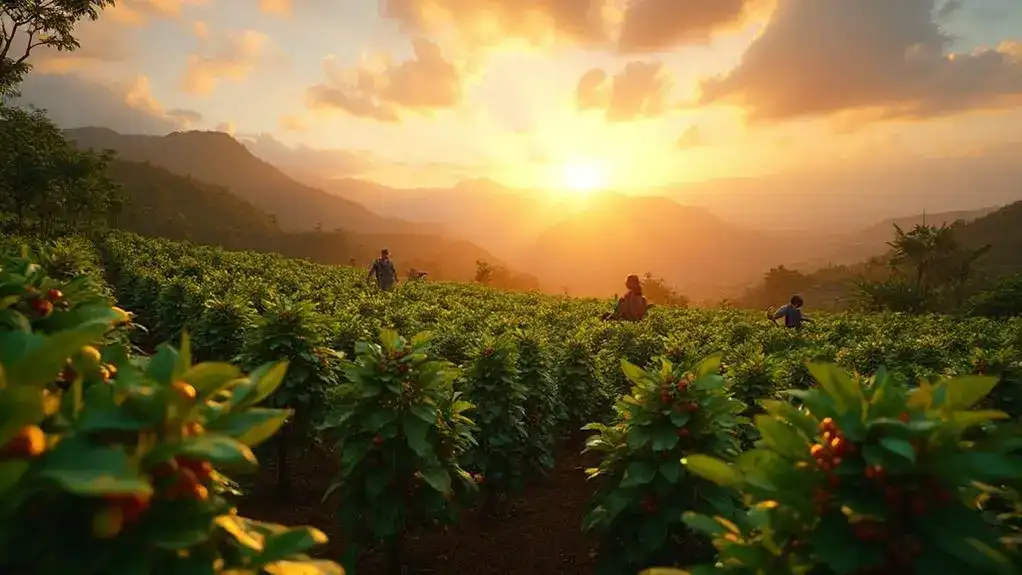Brazil’s coffee growing regions are essential to its economy and culture, primarily producing Arabica, Robusta, and specialty coffees. Minas Gerais, the largest producer, offers high-quality Arabica with distinct flavors across its sub-regions. São Paulo and Espírito Santo also contribute considerably, with São Paulo focusing on diverse Arabica types while Espírito Santo specializes in bold Robusta. Climate and altitude play critical roles in flavor development, impacting sweetness and acidity. However, challenges like climate change and pests threaten production. By exploring these regions, you’ll gain a deeper understanding of Brazil’s rich coffee heritage and the dedication behind its quality.
Importance of Coffee in Brazil

Coffee’s importance in Brazil can’t be overstated, as it’s not just a beverage but a crucial part of the nation’s economy and culture.
You’ll find that Brazil primarily grows three types of coffee:
- Arabica – Known for its smooth and complex flavor profiles.
- Robusta – Often used in espresso blends, boasting a stronger taste.
- Specialty Coffee – Grown in specific regions, celebrated for unique tasting notes and quality.
Understanding these types will give you insight into Brazil’s significant role in the global coffee market.
Types of Coffee Grown in Brazil
While Brazil is renowned for its diverse landscapes and rich culture, it’s the country’s coffee varieties that truly showcase its agricultural prowess.
Brazil primarily grows two main types of coffee: Arabica and Robusta. Each variety offers distinct flavor profiles, making Brazilian coffee unique.
Here are three notable coffee varieties found in Brazil:
- Arabica: Known for its sweet, complex flavors, often featuring chocolate and fruity notes.
- Robusta: Characterized by its bold, earthy taste, with nutty undertones, ideal for espresso blends.
- Specialty Coffees: Emerging from regions like Minas Gerais, these coffees exhibit unique qualities and diverse flavor profiles, attracting coffee connoisseurs worldwide.
Understanding these coffee varieties enhances your appreciation of Brazil’s rich coffee culture and its role in global coffee production.
Brazil Major Coffee Growing Regions
When you think about Brazil’s major coffee growing regions, Minas Gerais, São Paulo, Espirito Santo, Bahia, and Paraná come to mind.
Each area contributes unique flavors and quality to Brazil’s coffee landscape, thanks to their distinct climates and cultivation practices.
Understanding these regions helps you appreciate the diverse coffee profiles that Brazil has to offer.
Minas Gerais
When exploring Minas Gerais, you’ll find it’s home to several key coffee-growing regions, each contributing greatly to Brazil’s coffee landscape.
Sul de Minas, Cerrado Mineiro, Mogiana, Zona da Mata, and Chapada de Minas all offer unique climates and soils, resulting in a diverse array of high-quality Arabica coffees.
These areas not only produce a large portion of the country’s coffee but also showcase distinct flavor profiles that coffee enthusiasts often seek.
Sul de Minas
Sul de Minas is the heart of Brazil’s coffee production, known for its rolling hills and perfect growing conditions. The region specializes in Arabica beans, showcasing distinctive flavor profiles. Here’s a quick overview:
| Flavor Profile | Characteristics | Notable Varieties |
|---|---|---|
| Sweet | Fruity, chocolatey | Catuaí |
| Balanced | Medium body, acidity | Mundo Novo |
| Complex | Floral undertones | Bourbon |
| Rich | Full-bodied, smooth | Typica |
| Bright | Crisp acidity | Caturra |
Cerrado Mineiro
Cerrado Mineiro stands out as a premier coffee-growing region in Brazil, renowned for its exceptional Arabica beans. Known for distinct Cerrado flavors, the region emphasizes sustainable practices, ensuring both quality and environmental care.
| Flavor Profile | Sustainable Practices |
|---|---|
| Sweetness | Eco-friendly farming |
| Balanced Acidity | Water conservation |
| Caramel Notes | Shade-grown cultivation |
Mogiana
The Mogiana region, nestled between São Paulo and Minas Gerais, is a treasure trove for coffee lovers. Known for its rich volcanic soil and mountainous terrain, Mogiana production yields high-quality Arabica beans with distinct Mogiana flavors.
| Characteristic | Details |
|---|---|
| Altitude | 900-1,100 meters |
| Key Varieties | Mundo Novo, Catuaí |
| Flavor Profile | Sweet, balanced, aromatic |
Zona da Mata
Zona da Mata, a remarkable coffee-growing region in Minas Gerais, boasts rich soil and a favorable climate that create ideal conditions for coffee cultivation. Here, you’ll find an impressive array of coffee diversity, with flavors that attract specialty coffee aficionados.
| Feature | Description | Significance |
|---|---|---|
| Soil Quality | Rich and fertile | Enhances flavor profiles |
| Climate | Favorable for cultivation | Supports consistent growth |
| Coffee Varieties | Diverse Arabica selections | Appeals to connoisseurs |
Chapada de Minas
Chapada de Minas is a standout coffee-growing region in Minas Gerais, renowned for its high-altitude plantations that range between 900 to 1,200 meters. The Chapada diversity enhances the specialty flavors of its Arabica coffee, resulting in bright acidity and complex profiles. Check out the table below for key characteristics of this exceptional region:
| Characteristic | Detail |
|---|---|
| Altitude Range | 900 – 1,200 meters |
| Main Varieties | Catuaí, Mundo Novo |
| Flavor Profile | Bright acidity, complex |
| Climate | Mild temperatures, high humidity |
| Recognition | Specialty coffee region |
Triângulo Mineiro
Triângulo Mineiro is another prominent coffee-growing region in Minas Gerais, known for its diverse coffee farms and unique microclimates. The area produces exceptional Triângulo Mineiro coffee, showcasing a variety of flavors.
| Flavor Profile | Characteristics |
|---|---|
| Sweet | Notes of caramel and chocolate |
| Fruity | Citrus and berry undertones |
| Balanced | Smooth acidity |
| Nutty | Almond and hazelnut hints |
| Floral | Jasmine and lavender notes |
Noroeste de Minas
Noroeste de Minas is a key coffee-growing region in Brazil that benefits from favorable growing conditions, making it a significant contributor to the country’s coffee diversity. Known for its unique Noroeste characteristics, the region produces beans with rich Noroeste flavors, showcasing notes of chocolate and caramel. Here’s a quick overview:
| Characteristics | Flavors | Notable Varieties |
|---|---|---|
| High altitude | Chocolatey | Mundo Novo |
| Well-drained soil | Caramel | Catuaí |
| Mild climate | Sweet | |
| Diverse microclimates | Fruity | |
| Sustainable farming | Nutty |
São Paulo
In São Paulo, coffee production thrives in regions like Mogiana, Centro-Oeste de São Paulo, and Vale do Ribeira.
These areas are known for their unique growing conditions, which contribute to a diverse range of high-quality Arabica coffees.
You’ll find that the flavors from these regions vary greatly, reflecting the rich agricultural heritage of São Paulo.
Mogiana Region
Nestled between the states of São Paulo and Minas Gerais, the Mogiana region stands out as a prime area for coffee cultivation. Known for its ideal altitude of 900-1,100 meters, Mogiana produces beans with rich flavors and aromatic profiles.
| Aspect | Details |
|---|---|
| Mogiana Altitude | 900-1,100 meters |
| Mogiana Flavors | Sweet and balanced |
| Main Varieties | Mundo Novo, Catuaí |
Centro-Oeste de São Paulo
Centro-Oeste de São Paulo boasts a vibrant coffee-growing landscape characterized by its hilly terrain and favorable microclimates. While it produces rich, full-bodied coffee, this region faces coffee production challenges such as fluctuating weather and pests. Understanding Centro Oeste characteristics helps appreciate its unique offerings.
| Characteristics | Coffee Quality | Challenges |
|---|---|---|
| Hilly terrain | Rich flavors | Fluctuating weather |
| Favorable microclimates | Full-bodied profiles | Pest management issues |
| Varied altitudes | Unique taste notes | Market fluctuations |
Vale do Ribeira
Vale do Ribeira stands out as a unique coffee-growing region in São Paulo, known for its rich biodiversity and commitment to sustainable practices. The Vale’s importance lies in its diverse microclimates, which foster the growth of high-quality Ribeira coffee. This region emphasizes organic methods, enhancing both flavor and environmental stewardship.
| Feature | Details |
|---|---|
| Location | São Paulo |
| Coffee Type | Arabica |
| Farming Practices | Organic & Sustainable |
| Unique Aspect | Rich biodiversity |
Espírito Santo
When exploring Esp’írito Santo, you’ll find it’s Brazil’s second-largest coffee producer, primarily known for its Conilon (Robusta) coffee.
The Montanhas do Esp’írito Santo region stands out with its unique climate that fosters bold flavors and earthy notes in the beans.
This state’s focus on robust coffee production makes it a significant player in Brazil’s coffee landscape.
Montanhas do Espírito Santo
Nestled in the Caparaó mountains, Montanhas do Espírito Santo is celebrated for its unique coffee offerings. Here, you’ll discover Montanhas coffee, known for its specialty flavors. The high altitudes contribute to bright acidity and complex sweetness, making it a favorite among coffee enthusiasts.
| Flavor Profile | Characteristics |
|---|---|
| Bright Acidity | Crisp and vibrant |
| Complex Sweetness | Rich and layered |
| Specialty Varietals | Mundo Novo, Catuaí |
| Altitude Benefits | Improved quality |
| Unique Terroir | Distinctive taste |
Conilon (Robusta) Production
Espírito Santo stands out as Brazil’s second-largest coffee-producing state, particularly recognized for its Conilon (Robusta) coffee.
The region excels in conilon production, showcasing robusta characteristics like:
- Bold, earthy flavors
- Higher caffeine content
- Resilience to pests and diseases
These qualities make Conilon a favorite for espresso blends, enhancing the state’s reputation in the global coffee market.
Bahia
In Bahia, you’ll find two significant regions for coffee production: Chapada Diamantina and the Cerrado and Planalto da Bahia.
These areas benefit from advanced farming techniques that enhance the quality of Arabica beans.
As you explore Bahia’s coffee landscape, you’ll discover a blend of innovation and tradition that contributes to its growing reputation in the coffee world.
Chapada Diamantina
Often overlooked in discussions about Brazil’s coffee regions, Chapada Diamantina in Bahia is gaining recognition for its unique terroir and innovative farming practices. The area produces exceptional Chapada Diamantina coffee, characterized by vibrant flavors that capture the essence of its landscape. Here’s a closer look at what makes this region special:
| Aspect | Description | Note |
|---|---|---|
| Terroir | Unique soil and climate | Influences flavor |
| Coffee Varieties | Mainly Arabica | Known for quality |
| Flavor Profiles | Fruity and floral notes | Distinctive taste |
| Farming Practices | Innovative and sustainable | Focus on quality |
| Recognition | Gaining international acclaim | Growing popularity |
Cerrado and Planalto da Bahia
Cerrado and Planalto da Bahia are making waves in Brazil’s coffee industry, particularly for their innovative approaches to coffee production. These regions leverage advanced techniques to enhance quality.
| Feature | Description |
|---|---|
| Cerrado Benefits | High yields and uniformity |
| Planalto Techniques | Mechanized production methods |
Together, they produce exceptional Arabica beans with unique flavor profiles, setting new standards in Brazilian coffee.
Paraná
When you think of coffee regions in Brazil, Paranã mightn’t immediately come to mind, but it’s worth your attention.
The Norte Pioneiro do Paraná region is emerging as a notable player in the coffee industry, known for its sweet and creamy Arabica beans.
With its fertile red soils and seasonal climate variations, this area is crafting unique flavors that coffee lovers are beginning to appreciate.
Norte Pioneiro do Paraná
Located in the northern part of Paraná, Norte Pioneiro do Paraná is quickly becoming a remarkable coffee-growing region. This area is known for its sweet and creamy Arabica coffees, with fertile red soils enhancing unique flavors.
| Coffee Characteristics | Description |
|---|---|
| Flavor Profile | Sweet and creamy |
| Soil Type | Fertile red soils |
| Climate | Seasonal variations |
What Are Other Notable Coffee Growing Regions?
When you think of Brazil’s coffee landscape, don’t overlook regions like Rondônia, Tocantins, Acre, and Amazonas.
Each of these areas contributes unique flavors and characteristics to Brazil’s overall coffee production.
From Rondônia’s increasingly recognized specialty coffees to Acre’s focus on organic practices, these regions are worth exploring for any coffee enthusiast.
Rondônia
Rondônia stands out as a remarkable coffee-producing region in Brazil, gaining traction for its unique Robusta coffee varieties.
This area is known for:
- Diverse microclimates that enhance Rondônia coffee quality.
- Increasing focus on specialty production, elevating its reputation.
- Innovative farming techniques that improve flavor profiles.
As a result, Rondônia offers a distinct coffee experience that’s worth exploring.
Tocantins
Tocantins is an emerging gem in Brazil’s coffee landscape, capturing attention for its high-quality coffee production.
This region is gaining prominence thanks to its ideal climate and soil.
Key features of Tocantins coffee include:
- A mix of Arabica and Robusta varieties.
- Favorable growing conditions.
- Increasing recognition in specialty coffee circles.
Explore Tocantins to discover its unique contributions to Brazil’s coffee heritage.
Acre
Acre stands out as a unique player in Brazil’s coffee-growing regions, particularly known for its commitment to organic farming practices.
Here, you’ll discover:
- Sustainable practices that respect the environment.
- Flavor innovations that reflect the Amazon’s rich biodiversity.
- A focus on small-scale farmers who prioritize quality.
Acre’s dedication to these principles results in distinctive coffee with unique flavor profiles.
Amazonas
Although Amazonas is primarily recognized for its Robusta coffee production, it offers a unique perspective on Brazil’s coffee landscape.
Here are some key aspects of Amazonas coffee:
- Bold Flavors: Known for its strong, rich taste.
- Robusta Characteristics: Features earthy notes and higher caffeine content.
- Espresso Blends: Frequently used to enhance espresso’s body and depth.
This region contributes to Brazil’s diverse coffee culture, showcasing distinct qualities of Robusta.
How Do Climate and Altitude Influence Brazil Coffee Production?

Climate and altitude play essential roles in shaping the quality of Brazilian coffee.
Warmer temperatures can enhance sweetness in the beans, while cooler altitudes often lead to more complex flavor profiles.
How Climate Affects Coffee Quality
Influencing the growth and quality of coffee, climate and altitude play crucial roles in Brazil’s coffee production.
You’ll find that climate variations greatly impact flavor enhancement in coffee beans. Here are three key factors to take into account:
- Temperature: Ideal temperatures between 18-24°C promote best growth, affecting the bean’s sweetness and acidity.
- Rainfall: Consistent rainfall during the growing season guarantees healthy plants, while dry spells can lead to concentrated flavors.
- Sunlight: Proper sunlight exposure aids in the development of sugars within the beans, enhancing their overall flavor profile.
Role of Altitude in Flavor Development
When you think about coffee flavor, altitude plays a pivotal role in shaping the characteristics of the beans. Higher altitudes in Brazil lead to distinct altitude effects that enhance flavor profiles.
Here are three key ways altitude influences coffee:
- Increased Acidity: Higher elevations typically produce beans with a brighter acidity, giving them a more vibrant taste.
- Complex Flavors: The cooler temperatures at higher altitudes slow the maturation process, allowing for more complex flavor development in the beans.
- Balanced Sweetness: Altitude helps in achieving a balance of sweetness and acidity, resulting in well-rounded flavor profiles.
Understanding these altitude effects can deepen your appreciation for the unique coffees that Brazil has to offer, showcasing how environment shapes taste.
What Are the Challenges in Brazil Coffee Production?
When you’re looking at coffee production in Brazil, you’ll find several significant challenges.
Climate change is altering weather patterns, making it harder to predict harvests, while pests and diseases threaten crops and quality.
Additionally, economic factors, such as fluctuating prices and labor costs, can impact farmers’ ability to sustain their operations effectively.
Climate Change Impact
Climate change poses significant challenges to coffee production in Brazil, threatening the delicate balance of the regions that cultivate this beloved crop.
As temperatures rise and rainfall patterns shift, you’ll notice the impact on coffee quality and yield. To adapt, farmers must implement effective climate resilience strategies and sustainable farming practices.
Here are three key challenges:
- Increased Temperatures: Higher temperatures can stress coffee plants, reducing yields and affecting flavor profiles.
- Changing Rainfall Patterns: Irregular rainfall can lead to droughts or flooding, both detrimental to coffee cultivation.
- Soil Degradation: Climate change can exacerbate erosion and nutrient loss, making it harder to maintain healthy coffee farms.
Pests and Diseases
How do pests and diseases impact coffee production in Brazil? These challenges pose significant threats to the quality and yield of coffee crops.
Effective pest management and disease resistance strategies are essential for maintaining healthy coffee plants. Here are three major concerns:
- Coffee Leaf Rust: This fungal disease can devastate entire crops, leading to reduced yields and quality.
- Borer Beetles: These pests bore into coffee beans, causing direct damage and making the beans unsellable.
- Nematodes: These microscopic worms can damage root systems, leading to poor plant health and lower productivity.
Economic Factors
The challenges of pests and diseases aren’t the only hurdles facing coffee production in Brazil; economic factors also play a considerable role.
Here are three challenges that impact the industry:
- Market Fluctuations: Prices can vary considerably due to global supply and demand, affecting farmers’ income stability.
- Access to Resources: Limited access to financing and technology can hinder the adoption of sustainable practices necessary for improving coffee quality.
- Labor Costs: Rising labor costs can strain budgets, especially for small-scale farmers who rely heavily on manual harvesting.
These economic impacts make it essential for producers to focus on sustainable practices, ensuring they can adapt and thrive despite external pressures.
Understanding these factors helps you appreciate the complexities behind Brazil’s coffee production.
What Sustainable Practices Are Being Implemented in Brazil Coffee Farming?

In Brazil, sustainable coffee farming practices are gaining traction, focusing on organic production methods that minimize chemical use.
Technological advances in farming techniques help farmers optimize yield while caring for the environment.
Additionally, coffee cooperatives play a vital role in promoting sustainability, allowing small-scale farmers to share resources and knowledge for better environmental practices.
Organic Coffee Production
Sustainable practices in Brazil’s organic coffee production are transforming the way farmers cultivate their crops, promoting environmental health and enhancing coffee quality.
By focusing on sustainable farming methods, Brazilian farmers are implementing several key strategies:
- Crop Rotation: This practice helps maintain soil fertility and reduces pests, leading to healthier plants and better yields.
- Natural Fertilizers: Utilizing compost and organic materials minimizes chemical use, preserving the ecosystem and improving coffee flavor.
- Biodiversity Conservation: Encouraging diverse plant species on farms helps protect against disease and supports local wildlife, contributing to the overall health of the environment.
These efforts often lead to organic certifications, ensuring that consumers receive high-quality coffee that’s grown sustainably.
As a result, Brazil is gaining recognition for its commitment to environmentally friendly coffee production.
Technological Advances in Farming
Brazilian coffee farmers are increasingly adopting technological advances that complement their sustainable practices, enhancing both efficiency and quality.
By integrating precision agriculture into their methods, they’re able to monitor and manage resources more effectively.
Here are some key sustainable practices being implemented:
- Soil Health Monitoring: Farmers utilize sensors and drones to assess soil conditions, ensuring balanced nutrient levels for healthier crops.
- Water Management Systems: Advanced irrigation techniques, such as drip irrigation, minimize water waste while maintaining ideal moisture levels for coffee plants.
- Pest Management Solutions: Technology assists in monitoring pest populations, allowing farmers to apply eco-friendly treatments only when necessary.
These innovations not only promote sustainable farming but also improve the overall quality of Brazilian coffee, benefiting both producers and consumers alike.
Role of Coffee Cooperatives
Through the collaborative efforts of coffee cooperatives, farmers are enhancing their sustainability practices and boosting the quality of their coffee.
These cooperatives not only foster community support but also implement various sustainable practices that contribute to environmental health.
Here are three notable practices:
- Organic Farming: Many cooperatives promote organic cultivation methods, minimizing the use of harmful chemicals and preserving soil health.
- Water Conservation: Implementing efficient water management systems helps reduce water waste, ensuring a sustainable supply for coffee farming.
- Education and Training: Cooperatives provide farmers with training on sustainable techniques and best practices, empowering them to improve their yields and quality.
Brazil Coffee Flavor Profiles by Region
When exploring the flavor profiles of Brazilian coffee, you’ll discover that Minas Gerais offers sweet and chocolatey notes, thanks to its diverse microclimates.
In contrast, São Paulo and Espírito Santo showcase distinct flavors, with the latter known for its bold, earthy characteristics.
Meanwhile, Bahia and Paraná introduce unique profiles that highlight fruity and floral nuances, making each region a treasure trove for coffee enthusiasts.
Flavor Characteristics of Minas Gerais Coffee
Minas Gerais coffee is renowned for its rich and diverse flavor profiles, reflecting the state’s unique microclimates and altitudes.
When you explore the flavors from this region, you’ll discover:
- Sweetness: Often characterized by notes of caramel and chocolate, these flavors create a smooth, enjoyable cup.
- Fruity undertones: Many Minas Gerais coffees present fruity notes, ranging from berry to citrus, adding complexity and brightness.
- Balanced acidity: The region’s coffee typically features a pleasant acidity that enhances the overall flavor without overwhelming your palate.
This flavor diversity makes Minas Gerais a standout in Brazilian coffee, appealing to both casual drinkers and connoisseurs alike.
Understanding these characteristics can enrich your appreciation for this exceptional coffee-producing region.
Distinct Flavors from São Paulo and Espírito Santo
Sâo Paulo and Espirito Santo each contribute unique flavor profiles to Brazil’s coffee landscape, distinct from what you find in Minas Gerais.
In Sâo Paulo, the Mogiana region is renowned for its sweet and balanced coffees, often featuring floral notes and a smooth finish.
Meanwhile, Espirito Santo primarily produces Conilon (Robusta) coffee, known for its bold, nutty flavors and lower acidity.
Here are three key aspects of their contributions:
- Sustainable practices: Many farms in these regions implement eco-friendly methods, ensuring high-quality production while preserving the environment.
- Flavor innovations: Farmers continually experiment with processing techniques, enhancing flavor complexity and uniqueness.
- Diverse profiles: The combination of climate and soil types results in a rich variety of taste experiences.
Unique Profiles from Bahia and Paraná
What makes the coffee from Bahia and Paraná truly stand out in Brazil’s diverse coffee landscape?
Both regions deliver distinct flavor profiles that reflect their unique growing conditions.
Here’s what you can expect:
- Bahia flavors: Known for innovative farming, Bahia coffee often features fruity and floral notes, creating a complex and aromatic experience.
- Paraná coffee: The Norte Pioneiro do Paraná region offers sweet and creamy Arabica beans, with a smooth texture and rich body, thanks to its fertile soils.
- Growing techniques: Both regions utilize advanced cultivation methods, contributing to the overall quality and consistency of their coffee.
What Is the Future of Coffee Farming in Brazil?

As you consider the future of coffee farming in Brazil, think about how producers are adapting to climate change and implementing innovative farming practices.
You’ll find that global market trends present both challenges and opportunities for Brazilian coffee growers.
Staying informed about these developments can help you understand the evolving landscape of coffee production in this crucial region.
Adaptation to Climate Change
Climate change poses significant challenges for coffee farming in Brazil, compelling growers to adapt their practices to secure sustainability and quality.
To guarantee climate resilience and maintain coffee biodiversity, you can focus on these key strategies:
- Diversifying Varieties: Planting a mix of coffee species can help mitigate risks associated with climate fluctuations and pests.
- Implementing Sustainable Practices: Adopting organic farming and agroforestry not only supports environmental health but also enhances soil quality, leading to healthier coffee plants.
- Investing in Research: Collaborating with agricultural scientists can lead to the development of more resilient coffee varieties, safeguarding the future of coffee farming in a changing climate.
Innovations in Coffee Farming Practices
In Brazil, coffee farming is on the brink of transformation as innovative practices reshape the industry. Sustainable innovations and mechanized farming are paving the way for a more efficient future.
Here are three key trends to watch:
- Precision Agriculture: Farmers are using technology to monitor crop health, optimize resources, and improve yields, ensuring better quality coffee.
- Agroforestry Systems: Integrating coffee cultivation with native trees enhances biodiversity and soil health, contributing to sustainable practices.
- Automation: Mechanized farming techniques reduce labor costs and increase productivity, making it easier to manage large coffee estates.
These advancements not only aim to boost production but also promote environmental responsibility, ensuring Brazil remains a leader in the global coffee market.
Global Market Trends and Opportunities
Brazil’s coffee farming landscape is poised for significant evolution, driven by emerging global market trends and increasing consumer demand for specialty coffee.
As you look to the future, consider these three key opportunities:
- Coffee Sustainability: Farmers are adopting eco-friendly practices, appealing to environmentally conscious consumers and enhancing the quality of their beans.
- Market Demand for Specialty Coffee: There’s a growing interest in unique flavors and high-quality products, encouraging Brazilian growers to innovate and diversify their offerings.
- Technological Advancements: Embracing modern farming techniques can boost yields and improve coffee quality, positioning Brazil favorably in the global market.
Conclusion
As you’ve journeyed through Brazil’s vibrant coffee landscapes, you’ve witnessed how each region crafts its unique flavor narratives. From the rolling hills of Minas Gerais to Bahia’s innovative farms, the commitment of Brazilian farmers shines through every cup. Embracing sustainable practices and overcoming challenges, they guarantee that the rich tapestry of Brazilian coffee continues to thrive. The future holds promise, inviting you to savor not just the taste but the stories that each sip unfolds.

